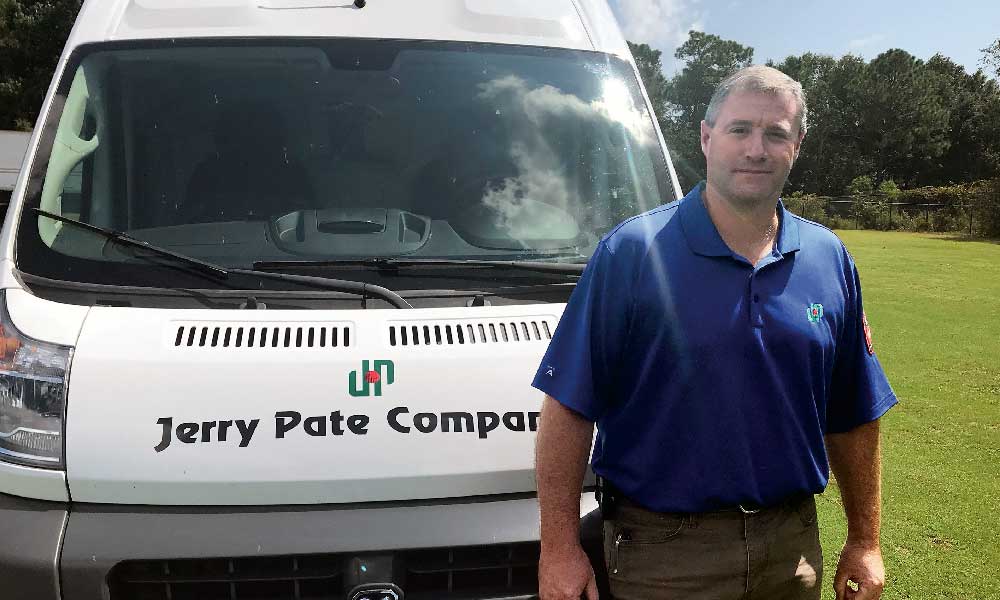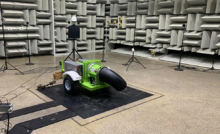Jerry Pate Company, behind the scenes of service


Eric Malloy Jerry Pate
Eric Malloy currently works as a Field Service Technician at Jerry Pate Company now for 3 years. Prior to his employment with Jerry Pate, he served as an Equipment Manager at Grand National in Opelika, AL, for 17 years. His background brings a unique perspective to equipment repairs from both end user and distributor perspectives.
Trades: Describe the differences between an equipment manager and Field Service Technician.
EM: “One of the major differences is the time associated with a repair. As an equipment manager you know a repair needs to be made as soon as possible, but you may not have a precise deadline. That usually gives you some flexibility and some room for error. As a Field Service Technician, you need to be extremely accurate. You are trying to arrive, troubleshoot, diagnose and repair as quickly as possible because you have multiple customers you are trying to see each day. Also, as an Equipment Manager you are mostly dealing with internal people within your organization, as a Field Technician you are always in front of the customer representing your company and the brand. In my experience as an Equipment Manager, a large part of my responsibilities included budgeting and managing the shop expenses. As a Field Tech, I am more focused on the service to our customers.”
Trades: Looking back as an Equipment Manager, what was your perception of Distributor Service Technician?
EM: “As an Equipment Manager I usually had good relationships with the distributor service technicians. I always saw field service as an advantage because the last thing an equipment manager wants to see or hear is that a machine needs to be picked up and taken to a shop off property. The distributor service team was a great resource for me to use for technical support when we needed a little more help or suggestions getting though a repair.”
Trades: What was the most difficult adjustment or change you had to overcome when you started working for a distributor?
EM: “I can think of two that stand out. First is the variety of equipment. As an equipment manager, we had a lot of equipment, and I thought we had everything out there, but as I started traveling around, there were several machines I had never seen or used before. Everything is very similar with engines, hydrostats, and electrical, so the troubleshooting was the same, but it took a while to become comfortable with the units that were new to me. Second is the work environment. Repairs that I would do in a shop as an equipment manager, I may find myself doing in an actual field or a gravel parking lot now.”
Trades: What is your greatest challenge today?
EM: “The biggest challenge that I face today is the technology that is being introduced into turf equipment. Technology is getting more and more sophisticated, which is good and bad. The good is that it’s making units run more efficiently and safer for the operators. The bad is that even with the software and diagnostic tools that service technicians have, the troubleshooting process must be more in depth and precise to solve either mechanical or electrical issues for customers. Technology changes yearly, and the only way to keep up with it is training. As a field service technician for Jerry Pate Company, we are certified technicians, and a large part of the job is training on equipment and software that is used on turf equipment today.”
Trades: Describe the overall repair process?
EM: “My approach to a repair is to gather as much information about the issues the unit is having. Information such as, what was the unit doing at the time of the issue, was the unit on flat ground or running uphill, did the unit make any unusual noises, did the unit loose power, any information that you can gather from the operators will help you to determine where to start the diagnostic troubleshooting process whether it’s electrical, mechanical or hydraulic. I also use a procedure called G.E.A.R.S
G.– Gather Information
E.—Evaluate Potential Causes
A.—Asses Performance
R.—Repair
S.—Solutions
These five steps can help target a solution by identifying the problem and end up saving time and money. Another tool we have to our advantage is the technology that gives us the ability to connect with the manufacturers that we communicate daily. For Example, Skype or Fac time can allow the engineers and support team at the manufacturer to see real-time data along with communication with the tech that is onsite for a repair.”
Trades: How is a warranty repair different than a standard repair? (documentation, parts recall, etc.)?
EM: “As far as the physical part of the repair there really is not much difference. The greatest difference is the documentation that we must provide back to the manufacture for a warranty repair. We must be accurate on the description of the issues the unit is having and all the test data we acquire while testing the unit. The difference is when doing standard repair, the customer is there with you and you can explain what you are testing and why, and they can physically see what is going on. With the warranty the manufacturer is not there, so they need as much information and test data as they can get for several reasons. First, with the test data you submit they can help find and correct the issue the machine, which ensures the correct parts are being replaced and will completely resolve the issue Second, is most manufacturers will use warranty data to spot trends in the field which helps them make production or supply changes to continuously improve.”
Trades: Describe a typical day as a Field Technician
EM: “The day starts out with me calling all the customers that I have appointments with that day and giving them an E.T.A on arrival so they can have the unit accessible for me to diagnose and repair. I do call the customer 48 to 72 hours in advance to ensure they are aware that I will be coming on-site to address the issues they are having with their equipment. Once there I communicate with the customer and address the issue the customer is having with the specific unit that he made the appointment for, when finished I will ask the customer if there is anything else I can help him with while onsite. If not, it’s on to the next appointment. Between appointments, I will return phone calls and e-mails from other customers. My goal is a help as many customers as I can, but while on-site with a customer I leave my phone in the van so I can give the customer I am with my full attention without distractions. As I finish the day, I type up all the reports for appointments that I had for the day and submit them to our office for processing. No two days are the same in the field, because there are so many variables from place to place. This all being said, the communication and process remain consistent.”
Recent Posts
Memphis Country Club: A Golfer’s Study in Precision and Tradition
If you have ever teed it up at Memphis Country Club, you know this isn’t…
Foley Company attains GCSAA Silver Partner Status
Foley Company, a leader in turf equipment innovation and technology, affirms its support of the…
Harrell’s continues longstanding support of the GCSAA Foundation
Harrell’s LLC, a leading distributor of customized agronomic products for turfgrass since 1941, has donated…
City of Orlando Announces New State-of-the-Art Driving Range at Dubsdread Golf Course
The City of Orlando is excited to announce the construction of a brand-new, state-of-the-art driving…
Discover Puerto Rico for Great Golf Trips and After-Round Activities, Amenities
Golfers cannot live by the game alone which is why Puerto Rico provides the perfect…
Q&A with a Multi-talented Golf Course Architect – Part 2: Making the Rounds – Installment 39
This column features recollections of the author’s 37 years as a golf writer. These installments…


